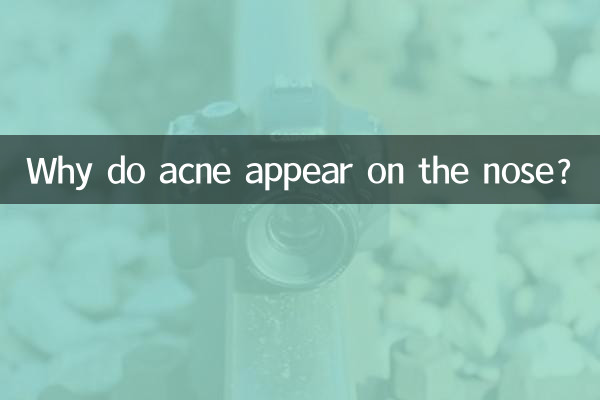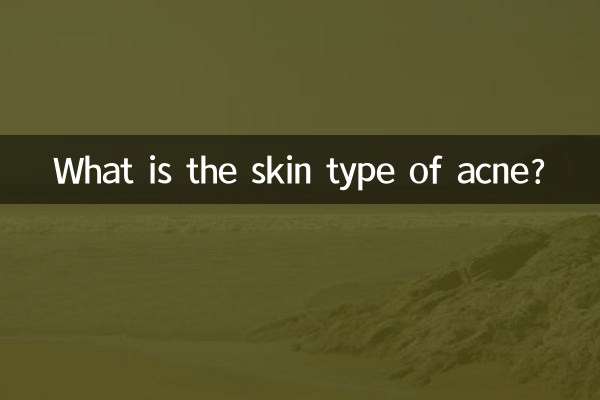Why do acne appear on the nose? ——Analysis of the causes and treatment methods of nose acne
Acne is a skin problem that troubles many people, and the nose, as one of the areas with strong oil secretion on the face, often becomes the "hardest hit area" for acne. Why are acne so common on the nose? This article will explain the causes of nasal acne from a scientific perspective, and provide structured data and practical suggestions to help you better deal with this problem.
1. Common causes of nose acne

Acne on the nose is usually closely related to the following factors:
| Cause classification | Specific instructions | Data support |
|---|---|---|
| Strong oil secretion | The density of sebaceous glands in the nose is high, and the amount of oil secreted is 2-3 times that of other parts. | According to dermatological research, the T-zone oil secretion accounts for 40% of the total facial volume. |
| clogged pores | Dead skin cells mix with oil to cause clogged pores | About 85% of acne cases are directly related to clogged pores |
| bacterial infection | Propionibacterium acnes thrives in clogged pores | 90% of inflammatory acne contains this bacteria |
| external stimulation | Frequent touching of nose, improper cleaning, etc. | People who touch their face more than 50 times a day have a 60% increased incidence of acne |
2. Analysis of types of nasal acne
Types of acne that may appear on the nose and their characteristics:
| Acne type | Appearance features | Causes | Handling suggestions |
|---|---|---|---|
| blackheads | Black dots, pore openings | Oil oxidation | Cleans gently and avoids squeezing |
| whiteheads | Small white bumps to close pores | keratin accumulation | Exfoliate regularly |
| red papules | Red, swollen and painful bumps | bacterial infection | anti-inflammatory treatment |
| Pustules | Pimples with pus on top | increased inflammation | Professional handling |
3. Practical methods to prevent and improve nasal acne
1.Proper cleaning:Choose a mild cleansing product and cleanse twice a day to avoid damage to the skin barrier caused by over-cleansing.
2.Oil control and moisturizing:Use oil-free moisturizing products to maintain skin's water-oil balance. Data shows that proper moisturizing can reduce the recurrence rate of acne by 30%.
3.Diet modification:Reduce the intake of high-sugar and high-fat foods. Research shows that people who eat a high-sugar diet have a 30% higher incidence of acne than people who eat a normal diet.
4.Avoid irritation:Don't touch your nose frequently with your hands and get rid of the bad habit of popping pimples. Hand contact with bacteria is one of the main causes of acne worsening.
5.Regular schedule:Get enough sleep and reduce stress. Lack of sleep can increase sebum secretion by 15%-20%.
4. When do you need medical treatment?
It is recommended to seek help from a professional dermatologist when the following situations occur:
- Acne has not healed for a long time and has not improved for more than 3 months
- Formation of large cysts or nodules
- Leaving obvious acne marks or scars
- Accompanied by systemic symptoms such as pain and fever
According to clinical statistics, the cure rate of acne patients who seek medical treatment in time is 40% higher than that of those who self-treat, and the scar incidence rate is reduced by 60%.
5. Latest research trends
Recent dermatology research on nasal acne found:
| Research direction | Main findings | Data support |
|---|---|---|
| Microbiome Research | Imbalance of nasal skin flora is positively correlated with acne severity | The proportion of harmful bacteria in the nose of patients is 2-3 times higher than that of healthy people |
| genetic factors | Specific genetic variant causes overactive sebaceous glands in nose | Genetic factors account for 50-80% of the risk of acne |
| environmental factors | Air pollution particles can worsen nasal inflammation | For every 10μg/m³ increase in PM2.5, the risk of acne increases by 12% |
Conclusion
Acne on the nose is the result of a combination of factors. By understanding its causes and taking targeted prevention and care measures, most people can effectively improve this problem. Remember, patience and persistence are key, and don’t expect to fix long-standing skin problems overnight. If self-care is not effective, seeking professional help promptly is the wisest choice.
Final reminder: Everyone’s skin condition is different. The information provided in this article is for reference only. Please consult a professional doctor for specific treatment options.

check the details

check the details